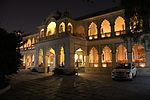Nahargarh Fort
Forts in RajasthanRajput architectureTourist attractions in JaipurUse Indian English from November 2018

Nahargarh Fort stands on the edge of the Aravalli Hills, overlooking the city of Jaipur in the Indian state of Rajasthan. Along with Amer Fort and Jaigarh Fort, Nahargarh once formed a strong defence ring for the city. The fort was originally named Sudershangarh, but it became known as Nahargarh, which means 'abode of tigers'. The popular belief is that Nahar here stands for Nahar Singh Bhomia, whose spirit haunted the place and obstructed construction of the fort. Nahar's spirit was pacified by building a temple in his memory within the fort, which thus became known by his name.
Excerpt from the Wikipedia article Nahargarh Fort (License: CC BY-SA 3.0, Authors, Images).Nahargarh Fort
New Rambah Road, Jaipur
Geographical coordinates (GPS) Address Nearby Places Show on map
Geographical coordinates (GPS)
| Latitude | Longitude |
|---|---|
| N 26.937255 ° | E 75.81549 ° |
Address
Nahargah Fort
New Rambah Road
302001 Jaipur
Rajasthan, India
Open on Google Maps









